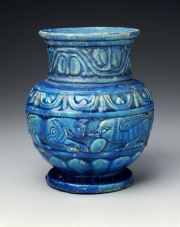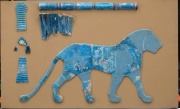Difference between revisions of "Faience"
Jump to navigation
Jump to search
| (2 intermediate revisions by 2 users not shown) | |||
| Line 1: | Line 1: | ||
| − | [[File:1993.574-SC20609.jpg|thumb|]] | + | [[File:1993.574-SC20609.jpg|thumb|Egyptian vessel<br>MFA# 1993.574]] |
== Description == | == Description == | ||
| − | + | [[File:20.1224-CR9369-d1.jpg|thumb|Nubian wall inlay<br>MFA# 20.1224]] | |
1) A highly colored, opaque glaze used for pottery, ceramic tiles, and architectural terracotta, particularly in the 16th-18th centuries in France and Germany. Faience was the French name given to a tin-glazed pottery originally made in Faenze, Italy. The Italian made pottery is now called [[majolica]]. | 1) A highly colored, opaque glaze used for pottery, ceramic tiles, and architectural terracotta, particularly in the 16th-18th centuries in France and Germany. Faience was the French name given to a tin-glazed pottery originally made in Faenze, Italy. The Italian made pottery is now called [[majolica]]. | ||
| Line 12: | Line 12: | ||
faience (Ned.); faïence (Fr.); faiança (Port.); fayence; majolica | faience (Ned.); faïence (Fr.); faiança (Port.); fayence; majolica | ||
| − | + | == Resources and Citations == | |
| − | == | ||
| − | |||
| − | |||
| − | + | * P.Nicholson, E.Peltenburg, "Egyptian Faience" in ''Ancient Egyptian Materials and Technology'', P.Nicholson, I.Shaw (eds.), Cambridge University Press, 2000, p. 177. | |
* ''Dictionary of Building Preservation'', Ward Bucher, ed., John Wiley & Sons, Inc., New York City, 1996 | * ''Dictionary of Building Preservation'', Ward Bucher, ed., John Wiley & Sons, Inc., New York City, 1996 | ||
| Line 27: | Line 24: | ||
* ''The American Heritage Dictionary'' or ''Encarta'', via Microsoft Bookshelf 98, Microsoft Corp., 1998 | * ''The American Heritage Dictionary'' or ''Encarta'', via Microsoft Bookshelf 98, Microsoft Corp., 1998 | ||
| − | * ''Encyclopedia Britannica'', http://www.britannica.com Comment: "faience." | + | * ''Encyclopedia Britannica'', http://www.britannica.com Comment: "faience." Accessed 4 Feb. 2005 . |
| − | * Wikipedia | + | * Wikipedia: http://en.wikipedia.org/wiki/Faience Accessed 4 Feb. 2005 |
[[Category:Materials database]] | [[Category:Materials database]] | ||
Latest revision as of 10:43, 7 August 2022
Description
1) A highly colored, opaque glaze used for pottery, ceramic tiles, and architectural terracotta, particularly in the 16th-18th centuries in France and Germany. Faience was the French name given to a tin-glazed pottery originally made in Faenze, Italy. The Italian made pottery is now called Majolica.
2) Any glazed earthenware.
3) Finely glazed Egyptian pottery.
Synonyms and Related Terms
faience (Ned.); faïence (Fr.); faiança (Port.); fayence; majolica
Resources and Citations
- P.Nicholson, E.Peltenburg, "Egyptian Faience" in Ancient Egyptian Materials and Technology, P.Nicholson, I.Shaw (eds.), Cambridge University Press, 2000, p. 177.
- Dictionary of Building Preservation, Ward Bucher, ed., John Wiley & Sons, Inc., New York City, 1996
- Robert Fournier, Illustrated Dictionary of Practical Pottery, Chilton Book Company, Radnor, PA, 1992
- Random House, Webster's Encyclopedic Unabridged Dictionary of the English Language, Grammercy Book, New York, 1997
- The American Heritage Dictionary or Encarta, via Microsoft Bookshelf 98, Microsoft Corp., 1998
- Encyclopedia Britannica, http://www.britannica.com Comment: "faience." Accessed 4 Feb. 2005 .
- Wikipedia: http://en.wikipedia.org/wiki/Faience Accessed 4 Feb. 2005

